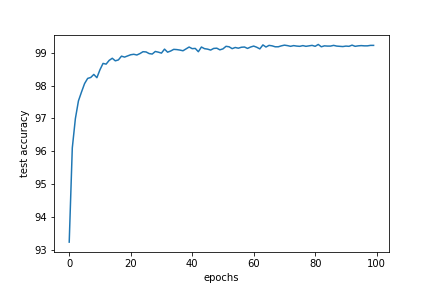SENSY Advent Calendar14日目の記事です。
12月からSENSY株式会社のAIチームで働いています。今回はDeep Learningへの応用ができるTheanoという数値計算ライブラリを用いて、チュートリアルを参考に畳み込みニューラルネットワーク(CNN)の実装をしたので、実装内容と結果をまとめました。細かい説明は省いています。
データはMNISTを用いました。
インストール
$ pip install Theano
エラーなくversion'1.0.1'がインストールができました。
動作確認として、以下のコードを実行します。
from theano import function, config, shared, tensor
import numpy
import time
vlen = 10 * 30 * 768
iters = 1000
rng = numpy.random.RandomState(22)
x = shared(numpy.asarray(rng.rand(vlen), config.floatX))
f = function([], tensor.exp(x))
print(f.maker.fgraph.toposort())
t0 = time.time()
for i in range(iters):
r = f()
t1 = time.time()
print("Looping %d times took %f seconds" % (iters, t1 - t0))
print("Result is %s" % (r,))
if numpy.any([isinstance(x.op, tensor.Elemwise) and
('Gpu' not in type(x.op).__name__)
for x in f.maker.fgraph.toposort()]):
print('Used the cpu')
else:
print('Used the gpu')
実行結果
[Elemwise{exp,no_inplace}(<TensorType(float64, vector)>)]
Looping 1000 times took 2.734218 seconds
Result is [ 1.23178032 1.61879341 1.52278065 ..., 2.20771815 2.29967753 1.62323285]
Used the cpu
CPUでの動作確認ができました。
MNISTのデータダウンロード
今回はscikit-learnのmldataを用いてダウンロードしました。
from sklearn.datasets import fetch_mldata
mnist = fetch_mldata('MNIST original', data_home='.')
>>> mnint
{'COL_NAMES': ['label', 'data'],
'DESCR': 'mldata.org dataset: mnist-original',
'data': array([[0, 0, 0, ..., 0, 0, 0],
[0, 0, 0, ..., 0, 0, 0],
[0, 0, 0, ..., 0, 0, 0],
...,
[0, 0, 0, ..., 0, 0, 0],
[0, 0, 0, ..., 0, 0, 0],
[0, 0, 0, ..., 0, 0, 0]], dtype=uint8),
'target': array([ 0., 0., 0., ..., 9., 9., 9.])}
28×28ピクセルの0~9の手書き数字データがダウンロードできました。
実装
インポート
numpy,theanoなどのライブラリをインストールします。
import numpy as np
import os
import time
import theano
import theano.tensor as T
from theano.tensor.nnet import conv2d
from theano.tensor.signal.pool import pool_2d
from sklearn.model_selection import train_test_split
from sklearn.datasets import fetch_mldata
データロード
データを読み込み、、80%を学習用、20%を評価用と分割して、複数の関数から参照できる共有変数とします。
def data_load(dataset):
mnist = fetch_mldata(dataset, data_home='.')
train_set_x ,test_set_x, train_set_y,test_set_y = train_test_split(mnist.data,mnist.target, train_size=0.8)
train_set = [train_set_x,train_set_y]
test_set = [test_set_x, test_set_y]
def shared_dataset(data, borrow=True):
data_x, data_y = data
shared_x = theano.shared(
np.asarray(data_x, dtype=theano.config.floatX), borrow=borrow)
shared_y = theano.shared(
np.asarray(data_y, dtype=theano.config.floatX), borrow=borrow)
return shared_x, T.cast(shared_y, 'int32')
test_set_x, test_set_y = shared_dataset(test_set)
train_set_x, train_set_y = shared_dataset(train_set)
rval = [(train_set_x, train_set_y),
(test_set_x, test_set_y)]
return rval
畳み込み層
CNNの畳み込み層を実装します。
class ConvLayer(object):
def __init__(self, rng, input, filter_shape, image_shape):
assert image_shape[1] == filter_shape[1]
self.input = input
fan_in = np.prod(filter_shape[1:])
fan_out = filter_shape[0] * np.prod(filter_shape[2:])
W_bound = np.sqrt(6.0 / (fan_in + fan_out))
self.W = theano.shared(
np.asarray(
rng.uniform(low=-W_bound, high=W_bound, size = filter_shape),
dtype=theano.config.floatX
),
borrow=True
)
b_values = np.zeros((filter_shape[0],),dtype=theano.config.floatX)
self.b = theano.shared(value=b_values, borrow=True)
conv_out = conv2d(
input=input,
filters=self.W,
filter_shape=filter_shape,
input_shape=image_shape
)
self.output = T.tanh(conv_out + self.b.dimshuffle('x', 0, 'x', 'x'))
self.params = [self.W, self.b]
ブーリング層
CNNのプーリング層を実装します。
class PoolLayer(object):
def __init__(self, rng, input, poolsize=(2, 2)):
pooled_out = pool_2d(
input = input ,
ws=poolsize,
ignore_border=True)
self.output = pooled_out
隠れ層
畳み込み、プーリング後のニューラルネットワーク部分の隠れ層を実装します。
class HiddenLayer(object):
def __init__(self, rng, input, n_in, n_out, W=None, b=None, activation=T.tanh):
self.input = input
if W is None:
W_bound = np.sqrt(6.0 / (n_in + n_out))
W_values = np.asarray(
rng.uniform(
low=-W_bound, high=W_bound, size = (n_in, n_out)),
dtype=theano.config.floatX
)
if activation == T.nnet.sigmoid:
W_values += 4
W = theano.shared(value=W_values, name='W', borrow=True)
if b is None:
b_values = np.zeros((n_out,),dtype=theano.config.floatX)
b = theano.shared(value=b_values, name='b',borrow=True)
self.W = W
self.b = b
lin_output = T.dot(input, self.W) + self.b
self.output = (
lin_output if activation is None
else activation(lin_output)
)
self.params = [self.W, self.b]
ロジスティック回帰
class LogisticRegression(object):
def __init__(self, input, n_in, n_out):
self.W = theano.shared(
value=np.zeros(
(n_in, n_out),
dtype=theano.config.floatX),
name='W',
borrow=True
)
self.b = theano.shared(
value=np.zeros(
(n_out,),
dtype=theano.config.floatX),
name='b',
borrow=True
)
self.p_y_given_x = T.nnet.softmax(T.dot(input, self.W) + self.b)
self.y_pred = T.argmax(self.p_y_given_x, axis=1)
self.params = [self.W, self.b]
def negative_log_likelihood(self, y):
return -T.mean(T.log(self.p_y_given_x)[T.arange(y.shape[0]), y])
def errors(self, y):
if y.ndim != self.y_pred.ndim:
raise TypeError('y should have the same shape as self.y_pred',
('y', y.type, 'y_pred', self.y_pred.type))
if y.dtype.startswith('int'):
return T.mean(T.neq(self.y_pred, y))
else:
raise NotImplementedError()
学習
def lenet(lr=0.1, epoch=100, dataset='MNIST original', batch_size=500):
rng = np.random.RandomState(23455)
datasets = data_load(dataset)
train_x, train_y = datasets[0]
test_x, test_y = datasets[1]
n_train_batches = int(train_x.get_value(borrow=True).shape[0] / batch_size)
n_test_batches = int(test_x.get_value(borrow=True).shape[0] / batch_size)
index = T.lscalar()
x = T.matrix('x')
y = T.ivector('y')
layer0_input = x.reshape((batch_size, 1, 28, 28))
layer0 = ConvLayer(rng,
input = layer0_input,
filter_shape = (10, 1, 5, 5),
image_shape = (batch_size, 1, 28, 28))
layer1 = ConvLayer(rng,
input = layer0.output,
filter_shape = (20, 10, 5, 5),
image_shape = (batch_size, 10, 24, 24))
layer2 = PoolLayer(rng,
input = layer1.output,
poolsize=(2, 2))
layer3 = ConvLayer(rng,
input = layer2.output,
filter_shape = (50, 20, 5, 5),
image_shape = (batch_size, 20, 10, 10))
layer4 = PoolLayer(rng,
input = layer3.output,
poolsize=(2,2))
layer5_input = layer4.output.flatten(2)
layer5 = HiddenLayer(rng,
input = layer5_input,
n_in = 50 * 3 * 3,
n_out = 100,
activation = T.tanh)
layer6 = LogisticRegression(input = layer5.output,
n_in = 100,
n_out = 10)
cost = layer6.negative_log_likelihood(y)
test_model = theano.function(
[index],
layer6.errors(y),
givens={
x:test_x[index * batch_size: (index + 1) * batch_size],
y:test_y[index * batch_size: (index + 1) * batch_size]
})
params = layer6.params + layer5.params + layer3.params + layer1.params + layer0.params
grads = T.grad(cost, params)
updates = [(param_i, param_i - lr * grad_i) for param_i,grad_i in zip(params, grads)]
train_model = theano.function(
[index],
cost,
updates=updates,
givens={
x:train_x[index * batch_size: (index + 1) * batch_size],
y:train_y[index * batch_size: (index + 1) * batch_size]
})
start_time = time.clock()
test_score = 0
for epo in range(epoch):
for minibatch_index in range(n_train_batches):
cost_i = train_model(minibatch_index)
test_loss = [test_model(i) for i in range(n_test_batches)]
test_score = np.mean(test_loss)
print ('epo : %d , test accuracy : %f' % (epo, 100.0 - test_score * 100))
end_time = time.clock()
今回はConv→Conv→Pool→Conv→Pool→Hidden→Outputという形で実装しました。
batch_sizeを500で100epoch学習しました。
実行結果
test accuracy : 99.22%
学習にかかった時間 : 310.67m
まとめ
今回はTheanoを用いてCNNを実装し、MNISTのデータを学習しました。
機会があれば、GPUでも動かしてみようと思います。
